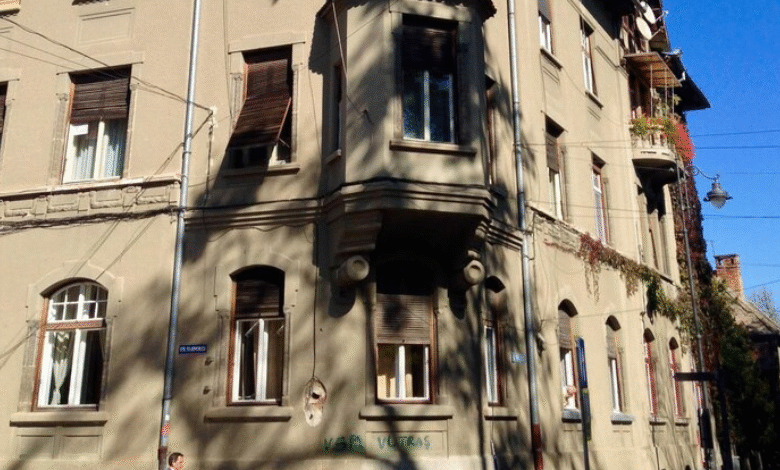House at 1 Farna Street in Szczecin

Nestled in the heart of Szczecin’s charming Old Town, the house at 1 Farna Street stands as a silent witness to centuries of history. This unassuming five-storey building might blend into the city’s architectural tapestry at first glance, but it harbors a remarkable secret: it’s the birthplace of Catherine the Great, Empress of Russia. Born within these walls on May 2, 1729, Catherine would go on to shape the course of European history, leaving behind a legacy that still resonates today.
This article takes you on an in-depth exploration of the house at 1 Farna Street, uncovering its rich history, architectural evolution, and modern-day significance. Whether you’re a history enthusiast, an architecture lover, or planning a trip to Szczecin, Poland, this guide offers everything you need to know about this iconic landmark. From its connection to one of history’s most powerful women to its place in Szczecin’s vibrant Old Town, let’s dive into the story of this extraordinary house.
Introduction: A Hidden Gem in Szczecin’s Old Town
Szczecin, a city steeped in history and culture, is home to many historic buildings, but few carry the weight of 1 Farna Street. Located at the intersection of Farna Street and Mary Square, this building is more than just a structure it’s a portal to the past. Its most famous claim to fame? Serving as the birthplace of Catherine the Great, a figure whose influence stretched far beyond the borders of Poland.
Today, the house stands as a testament to Szczecin’s resilience and its ability to preserve its heritage amid changing times. While it now functions as an office building for Powszechny Zakład Ubezpieczeń, a Polish insurance company, its historical significance remains palpable. In this guide, we’ll explore:
-
The house’s storied past, including its royal beginnings
-
Its architectural journey from neoclassical elegance to postmodernist innovation
-
Its current role and how visitors can experience it
-
The charm of Farna Street and Szczecin’s Old Town
-
Practical tips for exploring this historic site
Let’s start by stepping back in time to uncover the history that makes this house so special.
History of the House: From Royal Birthplace to Modern Office
The house at 1 Farna Street is woven into the fabric of Szczecin’s complex history, a city that has transitioned from Prussian rule to Polish governance over the centuries. Its story begins in the 18th century, when it played a pivotal role in the early life of a future empress.
The Birthplace of Catherine the Great
In the early 1700s, Szczecin then known as Stettin was a thriving city under Prussian control. The house at 1 Farna Street was owned by the local chamber of commerce and leased to Christian August, Prince of Anhalt-Zerbst, who served as the governor of Stettin. It was here, on May 2, 1729, that his daughter, Sophia Augusta Frederica, was born.
This child, later known as Catherine the Great, spent her earliest years in this house before her family relocated to the nearby Szczecin Ducal Castle. Little did anyone suspect that this modest beginning would lead to her becoming one of Russia’s most formidable rulers, reigning from 1762 to 1796. Her time in Szczecin laid the foundation for a life that would transform an empire, making 1 Farna Street a point of pride for the city.
Ownership and Changes Over Time
After Catherine’s family departed, the house continued to serve as a residential property, passing through various hands over the decades. By the 19th century, it remained under the ownership of the chamber of commerce, reflecting its status as a significant building in the community.
Szczecin’s history took a dramatic turn during World War II, when the city endured heavy bombing by Allied forces. Many historic structures were damaged or destroyed, and while specific records about 1 Farna Street’s fate during this period are limited, it’s reasonable to assume it faced challenges. Post-war reconstruction efforts likely contributed to its survival, though its appearance began to shift.
In the 20th century, as Szczecin became part of Poland, the house underwent a transformation. Its original neoclassical façade gave way to a more contemporary design, aligning with the city’s evolving architectural landscape. Today, it stands as an office building, a practical use that ensures its preservation while honoring its past with a commemorative plaque.
Here’s a brief timeline of key moments in the house’s history:
|
Period |
Event |
|---|---|
| 1729 |
Catherine the Great born in the house |
|
18th–19th Century |
Owned by the local chamber of commerce |
|
Post-WWII |
Restored or rebuilt after potential damage |
|
20th Century |
Façade updated to postmodernist style |
|
Present Day |
Houses offices of Powszechny Zakład Ubezpieczeń |
This timeline captures the house’s journey from a royal residence to a modern-day landmark, reflecting both its historical importance and its adaptability.
Architecture of the Building: A Tale of Two Styles
The house at 1 Farna Street is a fascinating case study in architectural evolution. Over the centuries, it has transitioned from a symbol of neoclassical grandeur to a modern structure with a postmodernist twist, mirroring broader trends in Szczecin and beyond.
Original Neoclassical Design
When it was constructed, likely in the early 18th century, the house boasted a neoclassical façade. This style, inspired by ancient Greek and Roman architecture, was popular across Europe during this period, especially in cities under Prussian influence like Stettin. Key features of neoclassical design include:
-
Symmetry: A balanced and harmonious appearance
-
Grandeur: Elements like columns or pilasters to convey elegance
-
Ornate Details: Cornices, friezes, and decorative moldings
-
Materials: Brick and stone, often painted in muted tones
While detailed records of the house’s original appearance are scarce, it likely embodied these characteristics, reflecting the status of its early occupants, including the Anhalt-Zerbst family. Imagine a stately five-storey building with evenly spaced windows, possibly arched, and subtle decorative flourishes that hinted at its importance.
Transition to Postmodernist Style
Fast forward to the 20th century, and the house underwent a dramatic makeover. The neoclassical façade was replaced with a postmodernist design, a style that emerged in the late 20th century as a playful counterpoint to the austerity of modernism. Postmodern architecture is known for:
-
Eclecticism: Blending historical and modern elements
-
Innovation: Use of glass, steel, and concrete in bold ways
-
Asymmetry: Departing from rigid symmetry for dynamic forms
-
Playfulness: Incorporating unexpected shapes or patterns
For 1 Farna Street, this shift likely occurred during post-war reconstruction or later renovations. The current façade might feature sleek lines, modern materials, and geometric accents, contrasting with its historic core. This transformation reflects Szczecin’s efforts to balance preservation with progress, a common theme in cities rebuilding after conflict.
Architectural Comparison
To illustrate the house’s evolution, here’s a comparison of its original and current designs:
|
Feature |
Original Design (Neoclassical) |
Current Design (Postmodernist) |
|---|---|---|
|
Façade |
Symmetrical, ornate |
Asymmetrical, sleek |
|
Materials |
Brick, stone |
Glass, steel, concrete |
|
Decorative Elements |
Columns, friezes |
Geometric shapes, modern textures |
|
Windows |
Uniform, possibly arched |
Varied sizes and shapes |
|
Aesthetic |
Grand, historical |
Contemporary, innovative |
This table highlights how the house has adapted to changing times while retaining its five-storey structure and historical essence. It’s a blend of old and new, much like Szczecin itself.
Current Status and Usage: A Modern Purpose for a Historic Building
Today, the house at 1 Farna Street serves a practical role in Szczecin’s bustling Old Town. It’s home to the offices of Powszechny Zakład Ubezpieczeń (PZU), one of Poland’s largest insurance companies. This modern use ensures the building remains maintained and relevant, even as it carries the weight of its storied past.
Inside, the space has likely been updated with contemporary office features think open-plan workspaces, meeting rooms, and modern lighting. However, efforts to preserve its historical significance are evident on the exterior, where a plaque marks it as the birthplace of Catherine the Great.
For visitors, the house isn’t a museum or tourist attraction in the traditional sense. The interior is off-limits to the public, but the exterior remains accessible. You can stand outside, admire the façade, and read about its history, making it a quick yet meaningful stop on any Szczecin itinerary.
Exploring Farna Street and the Old Town: A Step Back in Time
The house at 1 Farna Street is more than an isolated landmark—it’s part of the vibrant tapestry of Szczecin’s Old Town. Farna Street itself is a narrow, cobblestone lane lined with historic buildings, exuding an old-world charm that transports you back in time.
Nearby Attractions
The Old Town is packed with must-see sights, many just a short walk from 1 Farna Street. Here’s a handy table of key attractions and their distances:
|
Attraction |
Distance from 1 Farna Street |
Description |
|---|---|---|
|
Szczecin Cathedral |
200 meters |
A Gothic masterpiece with a towering presence |
|
Ducal Castle |
500 meters |
Former home of Pomeranian dukes, now a cultural hub |
|
Old Town Hall |
300 meters |
A Renaissance gem with a striking façade |
|
National Museum |
1 km |
Exhibits on art, history, and regional culture |
|
Wały Chrobrego |
1.5 km |
A scenic terrace with stunning river views |
These landmarks make the Old Town a treasure trove for explorers, with 1 Farna Street as a central point of interest.
The Charm of Szczecin’s Old Town
Beyond specific sites, the Old Town offers an ambiance that’s hard to resist. Reconstructed after World War II, its streets are a mix of restored historic buildings and subtle modern touches. You’ll find cozy cafes, boutique shops, and lively squares like Mary Square (Plac Mariacki), right near the house.
The area buzzes with cultural energy, hosting festivals, markets, and performances throughout the year. Whether you’re sipping coffee at a sidewalk cafe or admiring the Gothic spires of the Szczecin Cathedral, the Old Town invites you to linger and soak in its history.
Visiting the House at 1 Farna Street: What to Expect
While you can’t step inside the house at 1 Farna Street, there’s still plenty to appreciate. Here’s how to make the most of your visit:
-
View the Exterior: Take in the postmodernist façade and imagine its neoclassical past.
-
Read the Plaque: Learn about Catherine the Great and the house’s history firsthand.
-
Snap Photos: Capture the building against the backdrop of Farna Street’s cobblestones.
-
Explore Nearby: Pair your visit with a stroll to the cathedral or castle for a fuller experience.
Practical Tips for Visitors
-
Getting There: Szczecin is well-connected by train and bus from major Polish cities like Warsaw and Gdańsk. From the main station, it’s a short taxi ride or a 20-minute walk to the Old Town.
-
Best Time to Visit: Spring and summer offer mild weather and vibrant street life, though winter brings a cozy, festive atmosphere.
-
Accommodation: Stay in the Old Town at a boutique hotel or guesthouse to be steps away from 1 Farna Street.
FAQs: Answering Your Questions About 1 Farna Street
Here are some common questions about the house, designed to help you plan your visit or deepen your understanding.
Q: Can I visit the house at 1 Farna Street in Szczecin?
A: The house is currently an office building and isn’t open for public tours. You can view the exterior and read the historical plaque outside.
Q: What is the significance of 1 Farna Street in Szczecin?
A: It’s the birthplace of Catherine the Great, born in 1729, making it a key historical site tied to one of Russia’s most influential rulers.
Q: What architectural style is the house at 1 Farna Street?
A: Originally neoclassical, it now features a postmodernist façade, showcasing a blend of historical and modern design.
Q: How can I learn more about Catherine the Great’s connection to Szczecin?
A: Visit the house’s plaque, explore the Ducal Castle where she later lived, and check out the National Museum for regional history exhibits.
Q: Are there other historic buildings near 1 Farna Street?
A: Absolutely! The Old Town is full of gems like the Szczecin Cathedral, Old Town Hall, and Ducal Castle, all within walking distance.
Q: What’s the best time to visit Szczecin’s Old Town?
A: Spring and summer are ideal for pleasant weather and outdoor events, but winter offers a magical, festive vibe.
Conclusion: A Living Piece of History
The house at 1 Farna Street in Szczecin is a remarkable blend of history, architecture, and modern utility. As the birthplace of Catherine the Great, it connects us to a pivotal figure whose legacy spans continents. Its journey from a neoclassical residence to a postmodernist office building mirrors the resilience of Szczecin itself a city that honors its past while embracing the present.
Next time you’re in Poland, make a stop in Szczecin’s Old Town. Pause at 1 Farna Street, reflect on the young girl who once called it home, and let its story inspire you. Whether you’re drawn by history, architecture, or simply the charm of a cobblestone street, this house offers a window into a world worth exploring.



